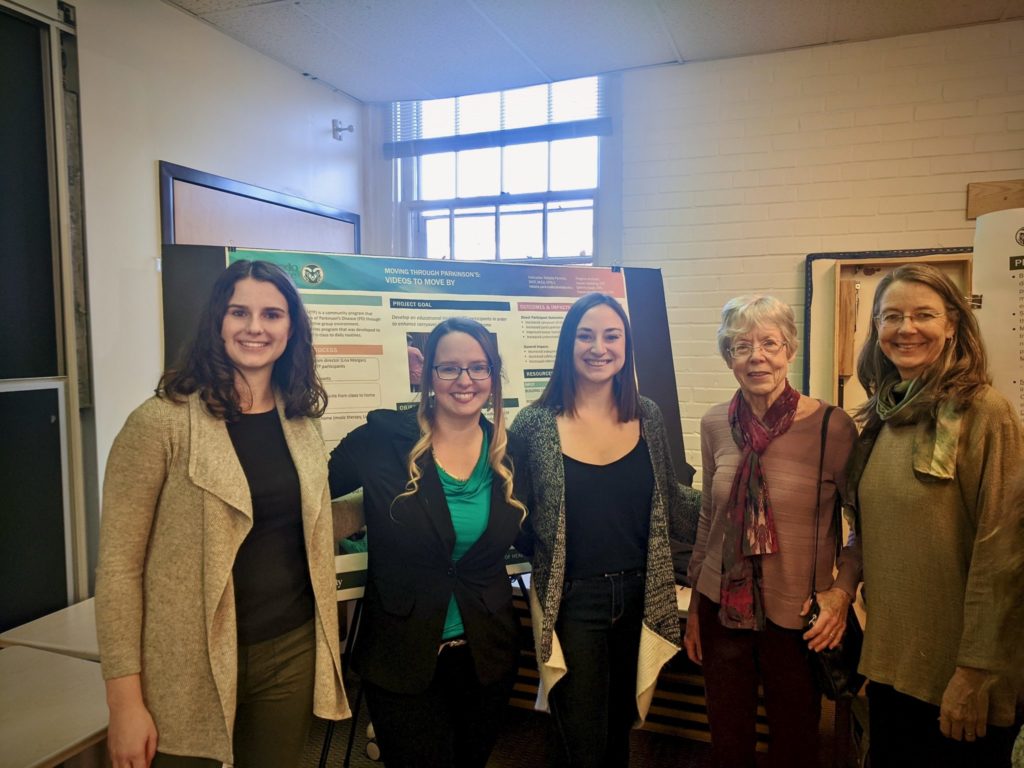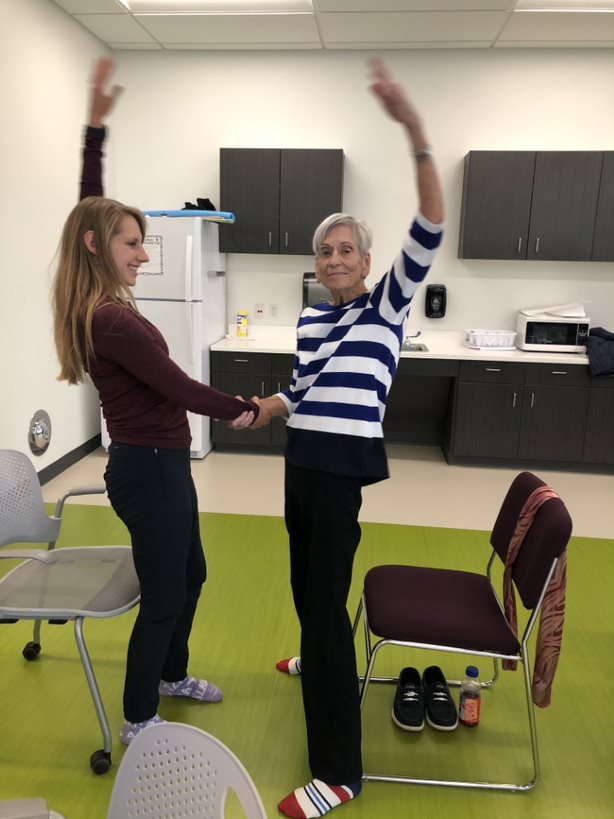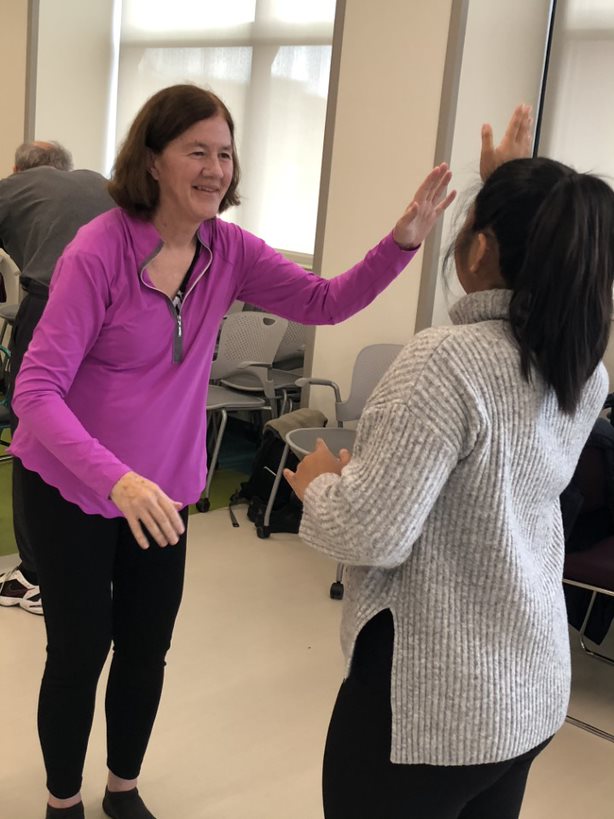
Story by Emmy Steele
“Combining movement with live music encourages both physical and emotional engagement,” shared Natalie Perkins, instructor in the Department of Occupational Therapy. “Range of motion is increased, dynamics and subtle nuances are emphasized, and moving and ‘singing’ with others contributes to improvements in overall well-being.”
Interested in others’ overall well-being while engaging in daily activities, second-year occupational therapy students at Colorado State University became involved with Moving Through Parkinson’s as part of class projects during the Fall semesters of 2018 and 2019. With a keen and well-trained eye to look at an individual’s stability, balance and movement while engaging in daily activities, otherwise known as occupations, students utilized their knowledge to help this community partner benefit from occupational therapy practice.
Weekly classes

Taught and coordinated by Lisa Morgan, instructor in the School of Music, Theatre and Dance at CSU, Moving Through Parkinson’s classes are designed for people living with Parkinson’s who are able to move and engage in a wide range of activity. This program was started as an extension of ongoing classes through the Music Therapy program at CSU and partners with CSU’s Center on Healthy Aging and the School of Music, Theatre and Dance and Parkinson’s Association of the Rockies.
Through exercises and movement patterns, Morgan and the participants work to improve balance, combat stiffness and rigidity and improve coordination and spatial awareness. The goals of the program are to build confidence to move with freedom and ease, acquire tools to use on a daily basis, build strength and endurance and, overall, to improve well-being as participants interact, share and move together.
For Perkins, the nature and goal of Moving Through Parkinson’s fits seamlessly with what occupational therapists are trained to assist with on a daily basis. This budding relationship allows the opportunity to blend what participants learn and experience in class with the benefits of occupational therapy.
Morgan shared, “This partnership and collaboration between Moving Through Parkinson’s and the occupational therapy program has been a great benefit to all involved. The occupational therapy students help to provide support and guidance for the participants and gain experience in this kind of movement/dance as therapy for people living with Parkinson’s.”
Videos to Move By
Continuing with what was started in 2018, Perkins shared that an extension of the program was developed this past fall when a group of second-year occupational therapy students asked Morgan how they could support the program. Morgan proposed contributing to her Videos to Move By series. For their semester-long program development project, three students worked with Morgan to create MTP Morning WakeUP with OT Tips. The video applies components from the class series to a morning wake up routine. The OT tips, developed solely by the students, provides participants with ideas for movements that are required for everyday living, such as getting dressed. The students discuss strategies for increasing independence, promoting health and well-being and conserving energy throughout an individual’s morning routine. This initial video is available to Moving Through Parkinson’s participants in which they and their caregivers can watch and use at home.
What is Parkinson’s disease?
According to the Parkinson’s Foundation, Parkinson’s disease is a common neurodegenerative disorder and an estimated 1 million Americans are living with Parkinson’s disease today. Often, individuals living with Parkinson’s disease experience difficulty with everyday tasks and routines due to impairments in movement because of neurochemical changes in the brain. These neurochemical changes can cause a wide array of symptoms but can result in stiffening movements and tremors.
Perkins stated, “This video allows the participants and their caregivers an opportunity to practice in their own environment and to use the benefit of a guided movement series at home in a way that they likely could not do without an instructional video.” She also shared that participants frequently told Morgan “they wish they could take her home”, and in a sense, this video allows them to do that.
In the end, “The collaborative project to develop videos for participants to access at home or away from class was a great process for all of us and I look forward to continued work to expand the video series,” commented Morgan.
Personal experience
The intention of the MTP Morning WakeUP with OT Tips is to help guide people through a gentle wake up while providing simple body awareness. One participant shared with Perkins that Videos to Move By enables her to practice her morning routine involving topics from the classes that she attended. The movement and music supports the mood for waking and preparing for your day. The participant also shared with Perkins that the occupational therapy tips at the end of the video were things that she had not thought about before, such as proper body positioning to put your sock on to reduce injury and conserve energy.
Complementary contributions

This upcoming year, Perkins would like to get more participants involved, which will allow them to create more videos targeting different daily occupations while incorporating live music. With
this, she hopes to promote and spread the word about the Moving Through Parkinson’s classes and all the benefits that this class offers. Inevitably, Perkins shared that she hopes these projects continue to increase the support services for individuals living with Parkinson’s in the community.
In addition, Perkins hopes that the development of these videos will begin a collaboration among the students from CSU’s School of Music, Theatre and Dance and the Department of Occupational Therapy. Creating this relationship will allow the videos to continue to merge movement and music through daily routines and activities. Occupational therapy students will be able to focus their attention on the importance of weight shifts and balance while performing movements required for daily occupations. In addition, dance students will be able to apply their dance training to the therapeutic setting, focusing on fluidity of movement, body control and building strength and coordination.
“These two disciplines complement each other,” shared Perkins. “It allows for a student-led experience between our academic programs.”
Hopes and dreams
Perkins sees the benefits of this collaboration with the Moving Through Parkinson’s program extending beyond the walls of a classroom. In the future, Perkins would love to see a student-led community clinic. Creating a student-run clinic would give CSU students an understanding of how they can impact their community by using their academic pursuits while simultaneously engaging in meaningful experiences through real world (practicum) learning opportunities.
The Department of Occupational Therapy is a part of CSU’s College of Health and Human Sciences.